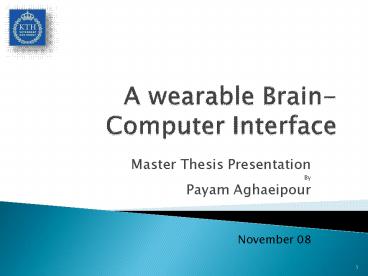A wearable Brain-Computer Interface - PowerPoint PPT Presentation
1 / 28
Title:
A wearable Brain-Computer Interface
Description:
... Architecture Mobile BCI (Video Demonstration) ... Both UDP and TCP low-level networking support MIDP 2.0 specification Multithread Sender ... – PowerPoint PPT presentation
Number of Views:313
Avg rating:3.0/5.0
Title: A wearable Brain-Computer Interface
1
A wearable Brain-Computer Interface
- Master Thesis Presentation
- By
- Payam Aghaeipour
- November 08
2
Story begins
- 10 months ago
- University of Sydney
- Web Engineering Group (EE Department)
- http//www.weg.ee.usyd.edu.au/index.html
- Supervisor Dr. Rafael A. Calvo
- Examiner Dr. Peter Sjödin
3
Outline
- BCI Background
- Goals of Wearable BCI
- Existing Solutions (their limitations)
- Architecture
- Mobile BCI (Video Demonstration)
- Implementation challenges
- Analysis of Results
- Conclusion and Future Work
4
What is BCI?
- Brain-Computer Interfaces (BCI)
- Interaction between the human neural system and
machines - Goal
- Enabling people (especially disabled) to
communicate and control devices by mere thinking. - BCI is a control system
5
Signal Acquisition
- Brain signals can be collected in different ways,
one of these methods is EEG (Electroencephalograph
y) - Non-invasive
- Mu Rhythms
- In awake people, even when they are not producing
motor output, motor cortical areas often display
812 Hz EEG activity (Mu Rhythm) - Movement or preparation for movement typically
causes a decrease in mu rhythms (motor imagery)
6
Signal Processing
- Feature Extraction
- The Translation Algorithm
7
Output Device
- Any controllable machines
- For answering yes/no questions
- For word processing at slow
- Wheelchair
- Virtual Reality
- Usually, Computer screen and the output is the
selection of targets or cursor movement
8
Wearable BCI
- Mobility
- Communication technologies
- Bluetooth
- 802.11
- GSM/GPRS
- PDA instead of stationary computer
- Dry Electrode instead of wet (reducing montage
time) - Making the BCI transparent
- No need to change electrodes for a reasonable
long time
9
Existing Solution
- Successful Story, Wearable BCI
- A successful transition of the whole BCI system
to the portable device - No machine learning
- Limited computational power (limited signal
processing) - BCI2000
- A general-purpose system for (BCI) research
- Source Module (new device new driver)
- Signal Processing Module (reusable, No Machine
Learning) - User Application Module (UDP/IP support to be
running in any machine) - Operator Module (controls the whole process)
- Platform
- Microsoft Windows 2000/XP
- C language
10
Our Architecture
11
Mobile BCI Playing Breakout on the mobile phone
12
BluesenseAD
- 8 analog to digital channels
- Sampling frequency up to 4000Hz
- Compliance of safety issues for humans brain
- Virtual Serial port
- Bluesense packets are like AT commands (not
compatible) - New Driver
- No existing library
13
BluesenseAD Driver Implementation
- New Diver in BCI2000
- C, event driven, serial communication
- Sample Scenario, Connection Establishment
14
Distributed Output Device
- Client/Server Application Module
- BCI2000 provides a way to directly communicate
with an external device through UDP - PDA may not support UDP
- Keep computation as little as possible in
portable device - Implemented in Java SE (Network Programming)
15
Breakout-Video Game
- Should be Simple
- No distraction ? no strategy
- Green bar
- 2 control signals (left, right)
- J2ME
- Development environment ! running environment
- Simulator (NetBeans IDE)
- Both UDP and TCP
- low-level networking support ? MIDP 2.0
specification - Multithread
- Sender (always sleep), receiver, game environment
16
BluesenseAD Evaluation
- Delay in BluesenseAD Driver
- Acceptable delay lt 0.5 Sec
- Signal collection
- A/D conversion
- Transmission
- Receiving and decision by PC and end user program
(BCI2000) - Sampling frequency, 128 or 256Hz
17
Delay measurement
- The same triangular signal from the signal
generator to both - BluesenseAD
- National Instruments data collector (NI USB-6251)
- More than a million samples/sec
- Timestamp which indicates the absolute time
- the sampled has been picked
- The Bluesense driver
- Timestamp that indicates the absolute time
- the data has been received in BCI2000
Delay T1-T2
Bluesense Time, T1
NI Time, T2
18
Finding Extrems
- Averaging near the peaks
19
Delay Parameters
- Sampling Frequency
- Block Size (BCI2000)
- Number of active channels
- Example one active channel
- Exception
- Bluesense Behavior
20
Delay in 4 and 8 active channels
- No exceptions!
21
Summary of Results
- Changes of driver delay based on parameters
22
BluesenseAD Scalability
- More active channels Less sampling frequency
- If sampling rate goes beyond supported value
corrupted signal - Low computational power (microcontroller)
- Packet lost (low communication speed)
23
BluesenseAD Scalability (Cont.)
- Maximum sampling frequency for various number of
sampling channels
24
Video Game, Breakout, Evaluation
- Parameters Definition
- Trial Number of experiment running
- Hit Number of hitting the bar to the green
indicator - Failed Number of moving the bar to the opposite
direction of green indicator - Aborted Number of experiments that does not lead
to Hit or Failed - Rate (Hit Abort)/Trial
25
Results
- 4 subjects, 4 sessions, 80 trials
- Game performance Cursor Task outcome
26
Conclusions
- Distributed framework
- Controlling the Breakout video game through brain
signals - BluesenseAD ? No ribbon cable
- Acceptable delay, sampling frequency
- Reliable
- Robust
- Game Server Application
- TCP support
- less dependent on BCI2000
- Simplicity
- Video Game
- Suitable for BCI experiment
- Can be run on Java-enabled handsets
27
Future Work
- Virtual Reality
- Bluesense, Sniff Mode
- Bluesense, Security
- Conference Paper (Accepted)
- Payam Aghaei Pour, Tauseef Gulrez, Omar Al-Zoubi
and Rafael A. Calvo. Brain-Computer Interface
Next Generation Thought Controlled Distributed
Video Game Development Platform. IEEE
Computational Intelligence and Games Symposium.
Perth, Australia.
28
Questions
- More Information
- KTH
- http//www.tslab.ssvl.kth.se/thesis/node/901
- University of Sydney
- http//www.weg.ee.usyd.edu.au/projects/penso
- payama_at_kth.se































